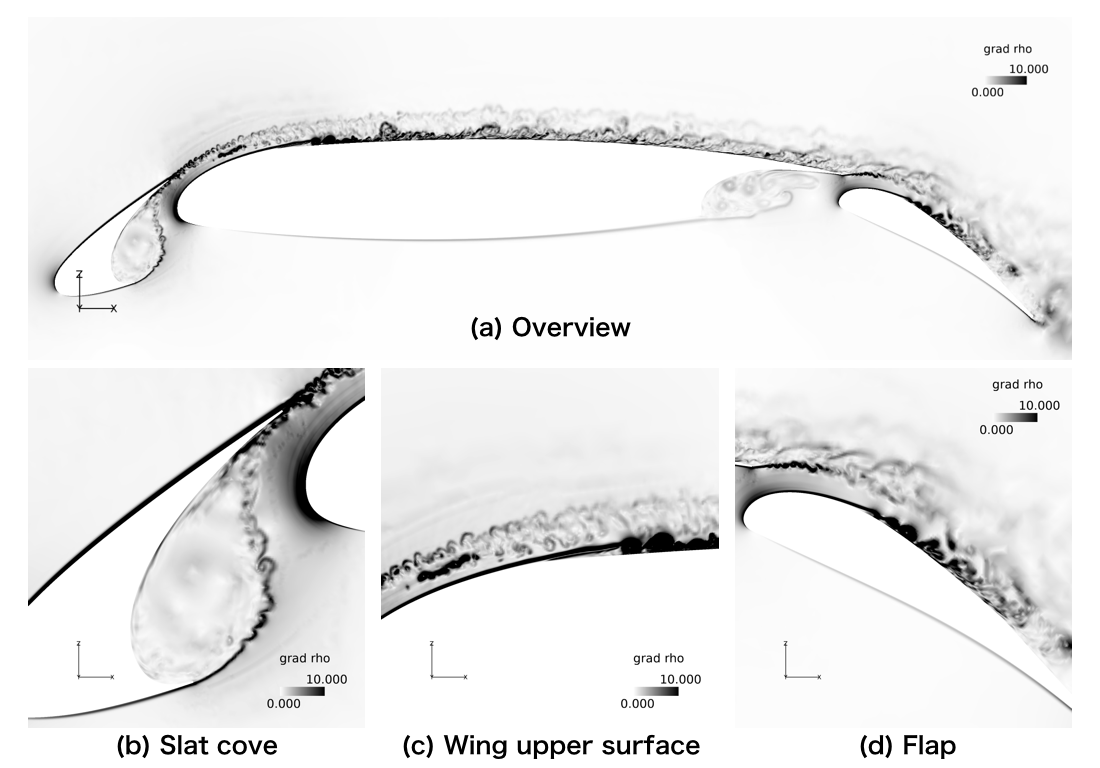Study of high-fidelity numerical schemes for compressible turbulent flows
JAXA Supercomputer System Annual Report April 2017-March 2018
Report Number: R17EACA04
Subject Category: JSS2 Inter-University Research
- Responsible Representative: Soshi Kawai, Tohoku University, Aerospace Engineering
- Contact Information: Hiroyuki Asada asada@cfd.mech.tohoku.ac.jp
- Members: Hiroyuki Asada, Soshi Kawai
Abstract
This study focuses on developing numerical scheme based on discontinuous Galerkin (DG) methods and large eddy simulation (LES) for high-fidelity compressible turbulent flow simulations around aircraft to enhance guidelines for designing next-generation low-noise aircrafts by clarifying the details of airframe noise generation.
Reference URL
Please refer to ‘Kawai Lab. – Aerospace Dept., Tohoku University‘.
Reasons for using JSS2
Massively parallel computations using supercomputer is mandatory for high-fidelity aeroacoustic simulations by DG methods and LES because of its high computational cost. DG methods are well known to be parallelization-friendly due to the high parallel efficiency and high execution efficiency.
Achievements of the Year
This study has developed fast high-order implicit DG methods (Asada et al., 2018, Computers&Fluids submitted) and parallelization-friendly implicit time integration schemes for high-order DG methods (Asada and Kawai, in preparation). In this year, we have carried out LES of aeroacoustic using the developed numerical schemes to assess its performances and investigate the physics of aeroacoustic. Aeroacoustic around a single cylinder is first computed to validate the developed solver, and then aeroacoustic around a high-lift device is simulated to demonstrate the capability for practical cases. In the computations of the aeroacoustic around a cylinder, 4th-order accurate DG methods and developed implicit time integration scheme are employed, and obtained solutions are compared with solutions by the 6th-order compact difference scheme reported by Khalighi et al. (AIAA Journal, 2010). Good agreements with the reference data for turbulent statistics such as the mean velocities and velocity fluctuations near the cylinder are obtained as well as for spectrums of velocity and pressure (sound) far from the cylinder. In the simulations of aeroacoustic around the high-lift device, obtained results are compared with experimental data and solutions by past works (Terracol and Manoha, AIAA paper, 2014), and characteristic flow and aeroacoustic are investigated. In the instantaneous field of density gradient (see Fig. 1), we can observe characteristic flows such as the impingement of the shear layer generated at the lower-edge of the slat, which makes the flows advecting in the slat cove and flows merging with the wake, and the laminar-to-turbulence transition on the upper-surface of the main-wing and the flap provoked by the interaction between the boundary layer and the wake. The existence of flow separation on the flap has been reported to highly depend on the numerical and experimental conditions, while such separation can be seen in the present simulation. In the instantaneous field of div(rho u) expressing the acoustic field (see Fig. 2), the aeroacoustic generated by vortex shedding at the slat trailing edge, which is well known to be dominant noise around the high-lift devices, is well simulated.
Similarly, we can expect the noise is generated at the wing trailing edge, but such noise is not so prominent in the present computation. The aeroacoustic is slightly generated at the location of laminar-to-turbulence transition in our simulation because the flow is separated before the transition, which is different trend with the work of Terracol and Manoha. We can also see the different trend of the aeroacoustic generated at the flap trailing edge. This can be attributed to the existence of the flow separation on the flap, and which is possibly derived from the size of the spanwise computational domain. In future works, we will conduct the simulation with wider spanwise computational domain than in the present simulation, and the physics of aeroacoustic will be quantitatively investigated in detail.

Fig.1: Instantaneous density gradient around a high-lift device obtained by LES with 4th-order implicit DG methods

Fig.2: Instantaneous div(rho u) around a high-lift device obtained by LES with 4th-order implicit DG methods
Publications
■ Peer-reviewed papers
1) H. Asada, S. Kawai and K. Sawada,” A quadrature simplification method for fast implicit discontinuous Galerkin schemes”, Computers&Fluids, accepted (in press).
2) H. Asada, S. Kawai, “A block Jacobi based high-order implicit discontinuous Galerkin scheme for turbulent flow simulations”, transactions of JSASS, in preparation.
3) H. Asada, S. Kawai and K. Sawada, “Aerodynamics prediction of NASA common research model using high-order DG methods”, Aerospace Technology, JSASS, 2017, 2017JSASS-D-17-00033.
■ Presentations
1) H. Asada, “An attempt to extend split forms to modal discontinuous Galerkin schemes”, Opening Ceremony of the UW-TU : AOS, Poster Session on Composite Materials for Aircraft and Aero Space Engineering, University of Washington, Seattle, Washington, April, 2017.
2) H. Asada and S. Kawai, “A kinetic energy preserving modal discontinuous Galerkin methods”, 49th Fluid Dynamics Conference/35th Aerospace Numerical Simulation Symposium, JSASS-2017-2113-A, Tokyo, Japan, June, 2017.
3) H. Asada and S. Kawai, “Aeroacoustic simulations using high-order implicit DG methods”, JSASS north conference, JSASS-2018-H041, Miyagi, Japan, March, 2017.
Usage of JSS2
Computational Information
- Process Parallelization Methods: MPI
- Thread Parallelization Methods: N/A
- Number of Processes: 160 – 3000
- Elapsed Time per Case: 280.00 hours
Resources Used
Fraction of Usage in Total Resources*1(%): 0.33
Details
Please refer to System Configuration of JSS2 for the system configuration and major specifications of JSS2.
| System Name | Amount of Core Time(core x hours) | Fraction of Usage*2(%) |
|---|---|---|
| SORA-MA | 2,763,076.97 | 0.36 |
| SORA-PP | 0.00 | 0.00 |
| SORA-LM | 0.00 | 0.00 |
| SORA-TPP | 0.00 | 0.00 |
| File System Name | Storage Assigned(GiB) | Fraction of Usage*2(%) |
|---|---|---|
| /home | 010.60 | 0.01 |
| /data | 9,776.23 | 0.18 |
| /ltmp | 2,170.14 | 0.16 |
| Archiver Name | Storage Used(TiB) | Fraction of Usage*2(%) |
|---|---|---|
| J-SPACE | 0.00 | 0.00 |
*1: Fraction of Usage in Total Resources: Weighted average of three resource types (Computing, File System, and Archiver).
*2: Fraction of Usage:Percentage of usage relative to each resource used in one year.
JAXA Supercomputer System Annual Report April 2017-March 2018


